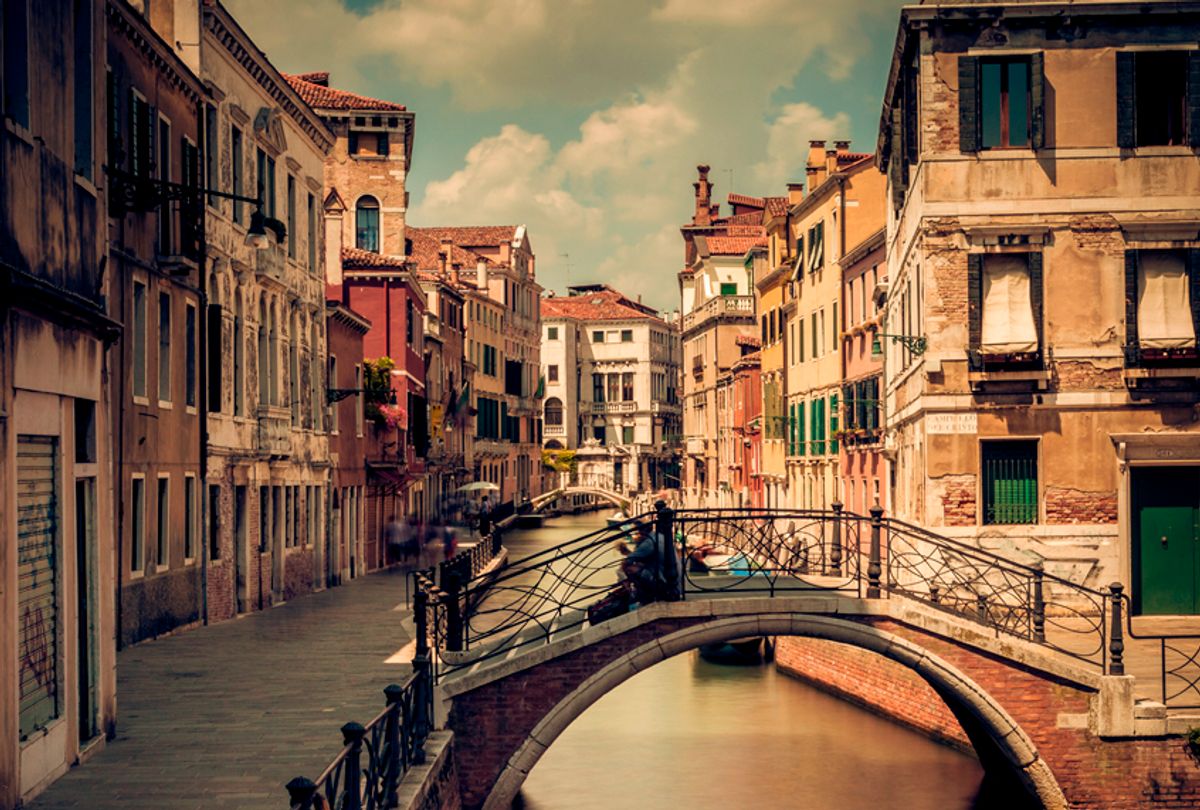There are very few downsides to staying in a two-room suite at the JW Marriott Venice, but if, like me, you’re a traveler who wakes before dawn to troll local food markets in search of exotic ingredients to cook, not having a kitchen is one of them. Still, on the very first day, propelled by the swoon-worthy descriptions of the fish at the Rialto Market in the late, great English food writer Elizabeth David's “Italian Food,” I rise early to pay my respects.
Cutting through the Piazza San Marco — blissfully empty before 8 a.m. — I head north through the arch of the Torre dell’Orologio, a Renaissance clock tower completed in 1499, zig-zagging my way toward the Rialto Bridge. Along the way I cross smaller bridges over the canals that would be streets in every other city, dodging tradesmen moving goods and workers removing refuse, all of them on foot, pushing and pulling hand-trucks.
Across the Rialto I search for the Campo San Giacomo di Rialto, a Gothic arcaded square with faded crimson walls, to find the venerable Caffè Vergnano, established in 1882, where the thick, delicious, perfectly pulled espresso is served in iconic matte-black cups.
Wandering through an unassuming portico at the northeast side of the piazza, I find the first of the two Rialto markets — the Erboria — or vegetable market, a riot of gorgeous greens, reds and yellows. While it’s always a treat to see zucchini with their flowers still attached, the veggie of the moment at practically every stand is the plum-colored baby artichoke, called castraure di Sant’Erasmo, a delicacy from a nearby island. There are several other sizes of classic green artichokes, too, but what I find most impressive are the already-cleaned ‘fondi di carciofi,’ thick, white, saucer-sized discs of artichoke bottoms floating in acidulated water (to keep them from turning brown).
Further ahead is the second Rialto market, the covered fish market, Pescheria, about which Elizabeth David wrote:
"In other markets, on other shores, the unfamiliar fishes may be vivid, mysterious, repellant, fascinating and bright with splendid color; only in Venice do they look good enough to eat. In Venice even ordinary sole and ugly great skate are striped with delicate lilac lights, the sardines shine like newly-minted silver coins, pink Venetian scampi are fat and fresh, infinitely enticing in the early dawn." — “Italian Food” (Knopf, 1954)
Entering the Rialto Pescheria my eyes keep going to the clams — I’m suddenly dying to cook spaghetti with clams! — there are so many beautifully diverse shapes and sizes, including golden-hued Vongola o Lupino, shiny, triangular Tellina with a shell that has Saturn-like gray rings, and, my favorite, thumb-sized Caparozzoli (which I later have for lunch, steamed in white wine, at Corte Sconta).
Since I can’t buy anything to cook, Simone, a local friend who walked over from the hotel with me, suggests we take a left at the end of the market and head to his favorite bàcaro, Cantina do Mori, one of the many small, local bars hiding in plain sight throughout the city. At these fabulous bàcari they serve a myriad of cicchetti (chee-KEHT-tee), Venice’s version of tapas — small plates of savory snacks, best nibbled over glasses of wine — yes, even at 8 a.m. There’s even a local phrase for bar-hopping (making the rounds tasting cicchetti with ombre, or small glasses of wine) from bàcaro to bàcaro: “giro di ombre.”
Among the best-known bàcari are All’Arco, Bancogiro, Do Spade and Merca. But we head to Cantina do Mori because it is thought to be the oldest bàcaro in Venice — dating back to 1462, it was Rudolph Valentino’s favorite and because ‘do Mori’ is the least touristed, thanks to its dark, brooding atmosphere, absence of seating and, well, its perfunctory staff.
When we enter we have to excuse ourselves through a group of well-dressed men of leisure. The ceiling is covered in every direction with antique copper pots. The wooden counter that runs the length of the room is richly worn, and the walls are covered in neighborhood memorabilia. Up high, toward the back, is what looks like an illuminated bird-house that turns out to be a shrine to a very small Madonna.
At one end of the counter are dozens of bottles of wine, some lined up for display, others chilling in a small, wooden half-barrel and four giant, straw-bottomed demijohns filled with local fermented juice, including Bardolino ‘Rosato,’ and Moscato Giallo. A glass display showcases an assortment of tramezzini, those tiny, crustless white bread sandwiches. Here they call them francobolli (postage stamps). I order a couple of the ones filled with what look like those plump, red shrimp I saw at the Market, accompanied by a glaze of delicate aioli.
At the other end of the bar are the rest of the cicchetti, including two types of baccalà mantecato (whipped salt cod) — with or without parsley and garlic — served atop rectangular slabs of white polenta. As the solemn barman holds a white plate to be filled, we point to marinated baby octopus the size of ping-pong balls; boiled egg-halves topped with anchovies; squares of ubriaco, the local cheese coated with Prosecco must; polpette in umido (meatballs cooked in broth); and — yes! — fondi di carciofi, the artichoke slices I saw at the market, served carmelized on the stove top with olive oil.
We order two glasses of local Tai — the Italian name for what used to be known as Tocai or Tocai Friulano, until a legal battle with the country of Hungary over its provenance stripped it away. A couple of other guys walk in and their friends shout their names in unison. I could stay here all day, every day.
How this foodie became a wine enthusiast
"Cork Dork" author gives her tips for learning how to taste wine and developing your palate.



Shares